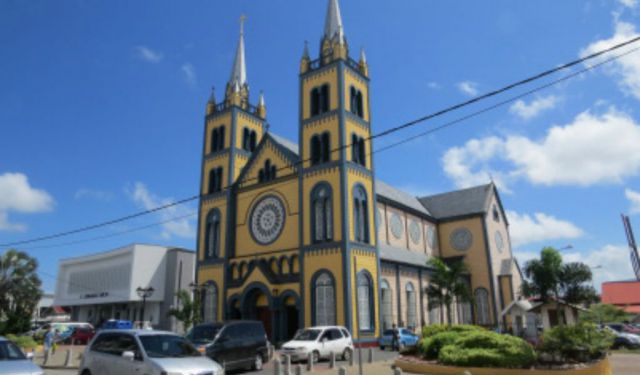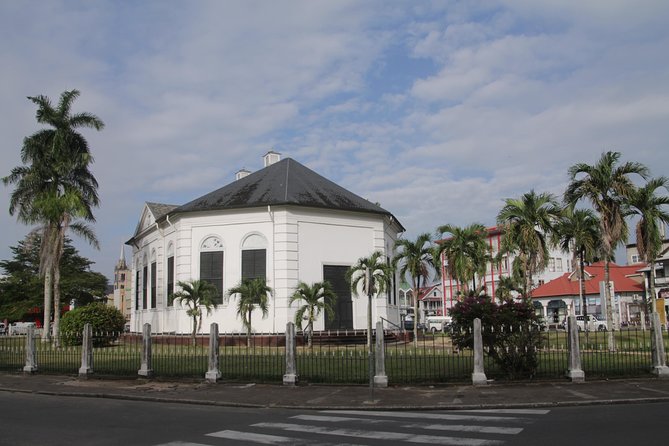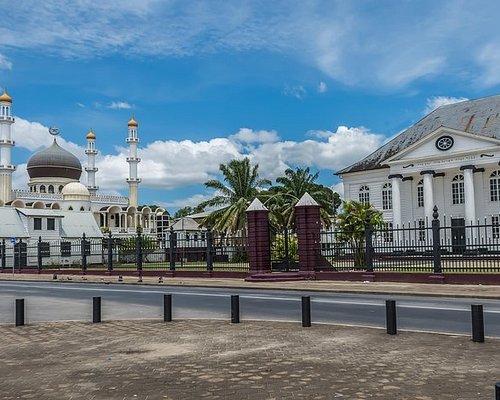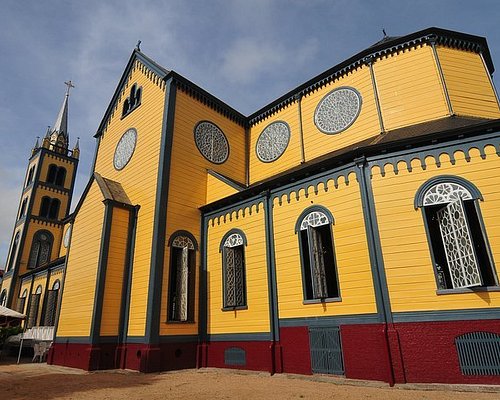Are you a fan of architecture? Ever wondered what it would be like to explore a city known for its stunning buildings? Well, you’re in luck! In this article, we’re going to take you on a self-guided architectural tour of Paramaribo, the capital city of Suriname. Get ready to be amazed by the rich history and beautiful architecture that this city has to offer.
Paramaribo is a UNESCO World Heritage Site, and it’s not hard to see why. As you wander through the streets, you’ll be greeted by a mix of Dutch, British, French, and Spanish influences in the architecture. The city is known for its colonial-style buildings, many of which date back to the 17th and 18th centuries. From the iconic wooden Dutch houses to the grand government buildings, Paramaribo has something to offer every architecture enthusiast.
In our upcoming article, we’ll give you a detailed guide to the must-see architectural gems of Paramaribo. We’ll take you on a virtual tour of the city, pointing out the most significant buildings and sharing interesting facts about their history. Whether you’re planning a visit to Paramaribo or simply want to learn more about its architecture, this article is the perfect starting point. So sit back, relax, and get ready to embark on a self-guided architectural adventure through the streets of Paramaribo.

Introduction to Paramaribo
Welcome to Paramaribo, the capital city of Suriname! This vibrant city is not only known for its rich cultural history but also for its stunning array of architectural landmarks. From colonial-era buildings to unique Art Deco designs, Paramaribo is a true architectural gem waiting to be explored. In this self-guided tour, you will have the opportunity to delve into the historical significance of the city, admire its diverse architectural styles, and uncover hidden gems along the way. So grab your maps and get ready for an unforgettable journey through the streets of Paramaribo!
Overview of Paramaribo
Paramaribo is nestled on the banks of the Suriname River and holds the distinction of being one of the few UNESCO World Heritage-listed cities in South America. This charming city boasts a remarkable blend of architectural styles, showcasing influences from its Dutch colonial past, as well as Afro-Caribbean and Javanese cultures. The city is divided into various districts, each with its own unique charm and historical stories to tell. So, put on your walking shoes and get ready to explore Paramaribo’s architectural wonders!

Historical significance of Paramaribo
Paramaribo has a rich and fascinating history that greatly influences its architecture. Originally inhabited by the indigenous Arawak and Carib tribes, the city later became a Dutch colonial settlement in the 17th century. The remnants of this colonial era can still be seen in the city’s historic buildings and fortifications. Over the years, Paramaribo has also grown and developed, incorporating influences from various cultural groups, resulting in a diverse tapestry of architectural styles that tell the story of its past.
Importance of architecture in Paramaribo
Architecture plays a crucial role in defining the identity of Paramaribo. The mix of architectural styles reflects the city’s multicultural heritage and demonstrates the creativity and adaptability of its residents. It is through the preservation and appreciation of these architectural treasures that the city can maintain its unique charm and attract visitors from around the world. The significance of Paramaribo’s architecture extends beyond aesthetics, as it serves as a tangible connection to the past while paving the way for future generations to understand and appreciate Suriname’s rich cultural heritage.

Planning Your Self-guided Tour
Before embarking on your self-guided tour of Paramaribo’s architectural wonders, a little planning can go a long way in ensuring a smooth and enjoyable experience. Here are some essential steps to consider:
Researching architectural landmarks
Begin by conducting thorough research on the architectural landmarks in Paramaribo. Make a list of the must-see buildings and structures that pique your interest. Delve into their historical background, architectural styles, and any other relevant information that will enhance your understanding and appreciation during the tour.
Creating a customized itinerary
Based on your research, create a customized itinerary that suits your preferences and time constraints. Consider the proximity of each landmark, as well as their opening hours, to effectively plan your route. Be sure to leave some room for spontaneous discoveries and detours along the way.
Obtaining necessary maps and guides
To navigate through the city with ease, obtain maps and guides that highlight the architectural landmarks of Paramaribo. These resources will not only provide valuable information but also help you navigate the city’s streets and neighborhoods. Familiarize yourself with the map before setting out on your journey.
Start of the Tour – Waterkant
Your architectural tour begins at Waterkant, the iconic waterfront of Paramaribo. This bustling area offers a picturesque view of the Suriname River and is lined with historical buildings that showcase the city’s colonial past. As you stroll along the promenade, you’ll be greeted by an impressive array of architectural gems that tell stories of Paramaribo’s rich history.
Exploring the iconic waterfront
Take a leisurely walk along the Waterkant and soak in the vibrant atmosphere. Admire the picturesque view of the Suriname River and enjoy the refreshing breeze. This area is a popular gathering spot for locals and visitors alike, providing an opportunity to observe daily life in Paramaribo.
Notable architectural landmarks along Waterkant
Waterkant is home to several architectural landmarks that are worth exploring. Start your journey at the striking Presidential Palace, an impressive neoclassical building that served as the Dutch Governor’s residence during colonial times. Continue to the iconic Central Market, a bustling hub of activity where you can immerse yourself in the city’s vibrant street life.
Learning about the historical background
As you explore the architectural landmarks along Waterkant, take the time to learn about their historical background. Each building has its own unique story to tell, and understanding the context in which they were built adds depth to your architectural journey. Engage with locals and tour guides to gain insights into the historical significance of these landmarks.

Continuing the Tour – Independence Square
From Waterkant, head towards Independence Square, the heart of Paramaribo. This bustling square is surrounded by impressive buildings, each with its own architectural splendor. As you explore this area, you’ll gain a deeper appreciation for the cultural significance of the city and its architectural treasures.
Visiting the heart of Paramaribo
Independence Square holds great cultural and historical importance to the people of Suriname. This central gathering place is surrounded by government buildings, historical monuments, and a vibrant market. It serves as a hub for festivities, celebrations, and public gatherings, providing a glimpse into the daily life of the city.
Exploring key architectural highlights
The architectural highlights around Independence Square are not to be missed. Admire the stately design of the Presidential Palace, which overlooks the square. Marvel at the grandeur of the Ministry of Finance building, an imposing example of neoclassical architecture. And don’t forget to visit the iconic Independence Monument, a symbol of Suriname’s journey to sovereignty.
Understanding the cultural significance
Take the time to understand the cultural significance of Independence Square and its surroundings. These landmarks represent Suriname’s struggle for freedom and independence from colonial rule. The architecture reflects the aspirations and resilience of its people, making them an integral part of the city’s heritage and identity.
Exploring Historic Districts
One of the highlights of your self-guided tour is the exploration of Paramaribo’s Historic Districts. As you venture into these UNESCO World Heritage-listed areas, you’ll be transported back in time, where you can witness a harmonious blend of architectural styles and immerse yourself in the city’s colonial past.
Discovering the UNESCO World Heritage-listed areas
Paramaribo’s Historic Districts encompass the city center and are characterized by their well-preserved colonial architecture. As you explore these areas, you’ll encounter a mix of wooden houses, brick buildings, and Dutch-style mansions. The UNESCO World Heritage status ensures the preservation and protection of these architectural treasures.
Admiring unique architectural styles
The Historic Districts of Paramaribo showcase a variety of architectural styles, ranging from Dutch colonial to Creole and Javanese influences. The wooden houses, known as “stadsboerderijen,” are a distinct architectural feature of Paramaribo. These elevated structures beautifully reflect the fusion of cultures that define the city’s unique identity.
Learning about the colonial history
As you wander through the Historic Districts, take the opportunity to learn about Paramaribo’s colonial history. Visit the Surinaams Museum and Fort Zeelandia to gain a deeper understanding of the city’s past. These cultural institutions provide valuable insights into Suriname’s colonial legacy and its impact on the architecture of the city.

Hidden Gems and Off-the-Beaten-Path
While exploring Paramaribo’s well-known architectural landmarks is a must, don’t forget to seek out the hidden gems and off-the-beaten-path treasures that lie beyond the tourist trail. These lesser-known architectural treasures offer a more intimate and unique perspective of Paramaribo’s architecture and provide an opportunity to interact with the local community.
Exploring lesser-known architectural treasures
Venture into the lesser-known neighborhoods and side streets of Paramaribo to discover hidden architectural gems. Take a detour from the main tourist areas and explore the residential districts, where you’ll find charming wooden houses adorned with intricate decorations and vibrant colors. These hidden treasures offer a glimpse into the daily lives of the locals.
Uncovering hidden stories behind buildings
As you uncover these hidden architectural treasures, take the time to uncover the stories behind the buildings. Engage with the local community and listen to their anecdotes and memories associated with these structures. You’ll be amazed at the wealth of knowledge and personal experiences that can be shared.
Interacting with the local community
One of the most enriching aspects of exploring Paramaribo’s architecture is the opportunity to interact with the local community. Strike up conversations with locals, visit neighborhood markets, and immerse yourself in the daily life of the city. The people of Paramaribo are proud of their architectural heritage and are always willing to share their stories and recommendations with visitors.
Art Deco and Surinamese Style
Paramaribo is renowned for its unique blend of Art Deco and Surinamese architectural styles. As you delve deeper into your architectural tour, you’ll encounter buildings that beautifully exemplify these distinct influences.
Appreciating the Art Deco influence in Paramaribo
Art Deco architecture has left a lasting impression on Paramaribo, with several buildings designed in this iconic style. From the elegant curves and geometric patterns to the use of vibrant colors, Art Deco buildings add a touch of glamour to the city’s streets. The Neve Building and the Klein Amsterdam Restaurant are excellent examples of Art Deco architecture in Paramaribo.
Examining the distinct Surinamese architectural style
Surinamese architecture is an amalgamation of various cultural influences and reflects the country’s multicultural heritage. The Surinamese style is characterized by its use of intricate wooden decorations, vibrant colors, and traditional Javanese and Creole elements. The Paramaribo City Hall and Saint Peter and Paul Cathedral showcase the beauty of this unique architectural style.
Visiting iconic Art Deco buildings
Make sure to visit some of the most iconic Art Deco buildings in Paramaribo during your tour. Admire the striking facade of the De Surinaamsche Bank building, which features Art Deco motifs and is considered one of the city’s architectural gems. Another must-see is the Kleine Combé Theater, an Art Deco cinema that still retains its original charm.
Religious Architecture in Paramaribo
Paramaribo is home to a diverse range of religious structures, reflecting the multicultural fabric of Surinamese society. As you explore the city, take the time to visit these places of worship and appreciate the architectural beauty that accompanies religious devotion.
Exploring diverse religious structures
Paramaribo is a true testament to religious tolerance and diversity. The city is home to a wealth of religious structures, including mosques, synagogues, and churches. Visit the stunning Mosque Keizerstraat and be captivated by its intricate Arabic-inspired architecture. The Neveh Shalom Synagogue, one of the oldest synagogues in the Americas, also holds architectural significance.
Learning about religious tolerance in Suriname
Suriname prides itself on its religious tolerance, where people of different beliefs coexist harmoniously. Use your visit to these religious structures as an opportunity to learn about Suriname’s commitment to religious freedom and harmony. Engage with community members and attend religious services or events if possible, to gain a deeper understanding of their faith and traditions.
Understanding the significance of each site
Religious structures hold great significance to the communities they serve. Take the time to understand the cultural and historical importance of each site. Paramaribo’s religious architecture reflects the unique blend of cultures in Suriname and serves as a testament to the country’s rich cultural tapestry.
Influential Architects of Paramaribo
As you explore the architectural wonders of Paramaribo, it’s important to highlight the influential architects who shaped the city’s landscape. These architects contributed their talent and vision to create the buildings that define Paramaribo’s architectural legacy.
Highlighting renowned architects in the city
Paramaribo has been home to many talented architects throughout history. One notable architect is C.L. van Drimmelen, known for his contributions to the city’s architectural landscape during the colonial era. Other renowned architects include Henri Menke, who designed several Art Deco buildings, and J.H. Monkau, who played a significant role in shaping the city’s urban development.
Examining their architectural contributions
Each architect has made unique contributions to Paramaribo’s architectural heritage. Van Drimmelen’s designs can be seen in buildings such as the Presidential Palace and the Fort Zeelandia Museum. Menke’s Art Deco influence can be witnessed in structures like the Klein Amsterdam Restaurant. And Monkau’s designs are evident in the city’s urban planning and development.
Appreciating their lasting impact
The architectural contributions of these renowned architects have left a lasting impact on Paramaribo’s landscape. Their buildings continue to be admired and appreciated by both locals and visitors alike. By showcasing these architects, we can pay homage to their creativity and vision, ensuring that their legacy lives on for future generations to appreciate.
Preserving Heritage and Conservation Efforts
Preserving Paramaribo’s architectural heritage is of utmost importance to ensure the city’s continued cultural and historical significance. Efforts are continuously being made to conserve and protect these architectural treasures for generations to come.
Importance of heritage preservation in Paramaribo
The preservation of Paramaribo’s architectural heritage is vital to maintain the city’s unique character. The buildings serve as tangible links to the past, allowing future generations to understand and appreciate the cultural and historical significance of Paramaribo. The preservation of these architectural treasures also contributes to the city’s tourism industry and economic growth.
Understanding conservation strategies
Conservation strategies are implemented to safeguard the architectural heritage of Paramaribo. These strategies involve the identification and restoration of significant buildings, the development of policies to regulate new construction, and the engagement of local communities in preservation efforts. By maintaining a delicate balance between preservation and development, Paramaribo can continue to evolve while honoring its architectural legacy.
Supporting local initiatives
You can contribute to the preservation efforts in Paramaribo by supporting local initiatives and organizations dedicated to conserving the city’s architectural treasures. Visit museums, attend cultural events, and donate to heritage preservation causes. By actively engaging with the community, you can help ensure the long-term preservation of Paramaribo’s architectural beauty.
Culinary Delights on the Architectural Tour
No tour is complete without indulging in the local cuisine, and Paramaribo offers a delightful array of culinary delights. Along your architectural journey, take the opportunity to savor traditional Surinamese dishes and explore the city’s vibrant food scene.
Exploring local cuisine along the way
As you navigate the streets of Paramaribo, you’ll encounter a diverse range of eateries and food stalls. Take the time to sample traditional Surinamese dishes such as roti, bara, and pom. These mouthwatering delicacies are a result of the fusion of flavors from African, Indian, Indonesian, and Chinese cuisines.
Notable restaurants near architectural landmarks
Paramaribo is home to several notable restaurants that combine delicious food with stunning architectural settings. For a truly immersive experience, dine at restaurants located near architectural landmarks. Experience the unique ambiance of Restaurant Peperpot, housed in a restored colonial plantation building. Or enjoy a meal at Spice Quest, located in an exquisite mansion overlooking the Suriname River.
Sampling traditional Surinamese dishes
In addition to dining at local restaurants, don’t miss the opportunity to sample traditional Surinamese street food. As you explore the city, keep an eye out for food stalls selling mouthwatering snacks such as bami, nasi, and bakabana. These delicious street foods offer a glimpse into Surinamese culinary traditions and are a favorite among locals and tourists alike.
Capturing the Memories
As you explore the architectural wonders of Paramaribo, it’s essential to capture the memories and preserve the experience for years to come. Here are some tips to ensure you make the most of your architectural tour.
Photography tips for architectural enthusiasts
If you’re an architectural enthusiast and love capturing the beauty of buildings, there are a few tips to keep in mind while exploring Paramaribo. Pay attention to lighting and shadows to highlight the finer details of the architecture. Experiment with different angles and perspectives to capture unique shots. And don’t forget to photograph the surrounding scenery to provide context to your architectural photographs.
Preserving the architectural tour experience
Preserving the architectural tour experience goes beyond photographs. Take notes during your journey to document your thoughts and observations. Record audio or video snippets to capture the ambient sounds and atmosphere of the city. These personal mementos will serve as cherished reminders of your time in Paramaribo and enhance your storytelling when sharing your experiences with others.
Sharing experiences on social media
Once you’ve captured your memories, share your experiences on social media. Post your favorite architectural photographs, along with insightful captions that showcase your appreciation for Paramaribo’s beauty. Engage with other travelers and architecture enthusiasts online, and inspire them to embark on their own architectural journeys.
Conclusion
As your self-guided architectural tour of Paramaribo comes to a close, take a moment to reflect on the remarkable beauty you have witnessed. Paramaribo’s diverse architectural heritage is a testament to the city’s multicultural past and promises an unforgettable journey through history and culture. By preserving and celebrating these architectural treasures, we can ensure that future generations will continue to be captivated by the charm and significance of Paramaribo. So, pack your bags, put on your walking shoes, and embark on your own architectural adventure in Paramaribo, Suriname’s architectural gem!